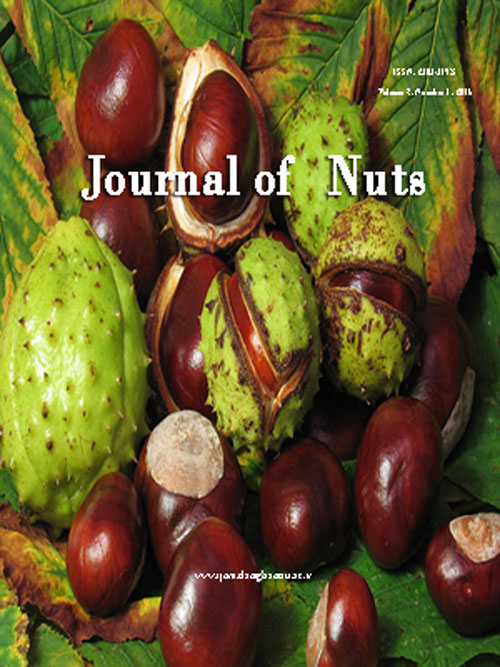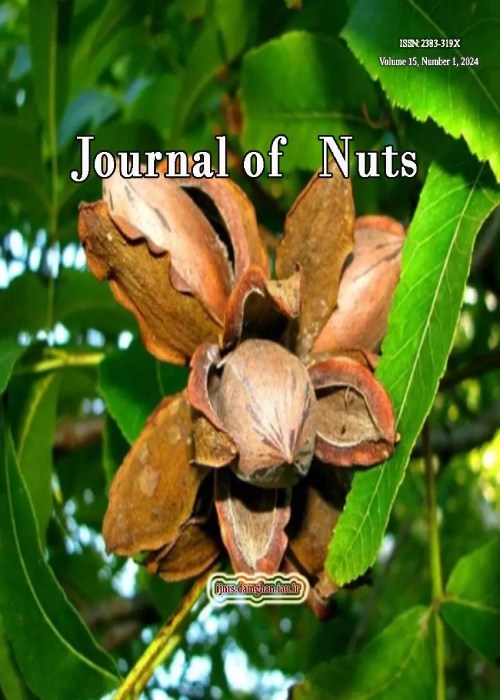فهرست مطالب

Journal of Nuts
Volume:8 Issue: 1, Winter-Spring 2017
- تاریخ انتشار: 1396/02/31
- تعداد عناوین: 8
-
-
Pages 1-10Guilan Province is the biggest hazelnut producer in Iran. Over 70% of hazelnut production cost is due to its manual harvesting. Therefore, study on all aspects of its cultivation mechanization is necessary to sustain its production. This study focused on identifying factors that affect the development of hazelnut harvesting mechanization in Guilan Province, Iran, using a three-round Delphi technique. The technical panel of the study consisted of 27 hazelnut production in Eastern Guilan. The factor observing engineering principles in the construction of new hazelnut orchards (row planting at appropriate density) was identified as the most important driving factor with about 99% consensus from experts. Also, the factors devising regional and provincial macro plans for developing orchard mechanization and development of mechanized irrigation of orchards with convenient methods tailored to local conditions were ranked the second and third most important driving factors, respectively, with 91.30% and 90.05% consensus of experts. The most important inhibiting factor was found to be the slope of most hazelnut farms with 96% consensus of experts. The second most important inhibiting factors were lack of appropriate roads for quick and convenient access to hazelnut cultivation machinery and hazelnut growers limited financial capability with 94.75% consensus. These results indicated that it is necessary to address the modification of old gardens to oblige observing the construction principles of orchards tailored to hazelnut mechanical harvesting and to purposefully and specifically support research on the design and manufacture of small-scale implements for hazelnut harvesting tailored to local conditions of hazelnut orchards in Guilan Province.Keywords: Delphi, Driving factors, Hazelnut harvesting, Inhibiting factors, Mechanization
-
Pages 11-20Several species of Phytophthora cause crown and root rot diseases of herbaceous and woody plants. Crown and root rot of pistachio trees cause significant damages in infected orchards. The effect of foliar application with Elite (fosetyl-Al) in 2 and 2.5 g/l was evaluated in greenhouse experiments. The frequency of mortality, fresh and dry weight of roots and shoots, height, intensity of crown root colonization using CAMA-PARP medium was determined. Under greenhouse experiments, foliar application with Elite increased height, fresh and dry weight of shoots and root either in inoculation with and without Phytophthora drechsleri. The effects of Elite were more pronounced in roots, which increased the fresh and dry weight of root 1.3 and 2.5 times compared to those not sprayed with Elite, respectively. On the other hand, the application of Elite before or on the day of inoculation significantly reduced the frequency of mortality, which ranged from 35 to 90% (P ≤ 0.01). Crown and root colonization of pistachio seedling was affected by both the concentration of Elite and reduced the frequency of crown and root colonization of seedling. When fungicide and pathogen were applied at the same time, the frequency of colonization reduced to 18% and 36% for 2 and 2.5 g/l, respectively, and 43% and 60% when seedlings were treated with fungicide before P. drechsleri inoculations. The highest effect was seen in foliar application of Elite seven days before inoculation in 2.5 g/l. Further investigations have been conducted to understand the effect of Elite in infected trees as well as modeling of Elite application via soil drench, foliar application or trunk injection.Keywords: Aluminium Fosetyl, Crown, Elite, Foliar spray, Phytophthora, Root rot
-
Pages 21-30The first step in walnut breeding programs is to identify and evaluate superior genotypes of fruit trees. Hence, there are various walnut breeding programs in various areas of Iran. A study aimed to evaluate the morphological and chemical characteristics of selected superior genotypes of walnut was conducted in the Shahroud region in 2011-2012. The following genotypes were selected in this study as the best walnut genotypes: X-18 homogamous genotypes due to desirable late leafing; genotype X-11 for its high percentage of kernel production, easily removal of shell, thin shell; genotype X-52 due to its kernel plumpness compared to other genotypes, thin shell and high percentage of kernel and genotype X-70 for its kernel brightness, easily kernel extracting and high percentage of kernels. The X-49 and X-5 genotypes had the highest amount of linoleic and linolenic fatty acids and higher nutritional quality compared to other genotypes. Three genotypes, X-3, X-11 and X-22, had the highest amount of oil. Genotypes X-9 and X-45 had the highest amount of protein. The difference between oil content and fatty acid compositions was presumably due to genetic diversity and ecological conditions of the studied genotypes cultivation.Keywords: Juglans regia L, Morphological traits, Superior genotypes, Walnut
-
Pages 31-40Roasting has considerable effects on the quality of cream made of nuts. In this study, the roasting conditions of walnut kernels were optimized based on the stability parameters of the produced cream. Temperatures of 100-150°C for 10-30 minutes were used to roast walnut kernels. The amount of oil separation, peroxide, acidity and Thiobarbituric acid values of the cream, as well as color parameters were determined after three months of storage at 25°C. The results showed that the oil separation increased with temperature and time of roasting (from 4.16% at 100°C/10min to 7.85% at 150°C/30min). Peroxide, acidity and thiobarbituric acid values were significantly affected by temperature and time of roasting. In addition, it was shown that as the temperature increased, the redness and yellowness increased, but the lightness of the samples decreased. Finally, the temperature of 116°C for 12 minutes was chosen as the optimized roasting conditions for producing walnut cream.Keywords: Nut spread, Oil separation, Optimization, roasting, Walnut cream
-
Pages 41-48This study was conducted to determine the best pollinizer for five selected pecan cultivars in southwest of Iran at Safiabad Agricultural Research Center in 2014-2015. The cultivars included: 'GraTex', '10J', 'Wichita 6J', 'GraKing', 'Choctaw' as pollinated cultivars (♀) and 'GraTex', 'Peruque', 'Comanche 4M', '10J', 'Wichita 6J', 'Mohawk', 'Mahan', 'Stuart 2J', '3J', 'Stuart 4J', 'GraKing', 'Choctaw', 'Apache', '6M', 'Wichita 7J' and 'Comanche 5M.' as pollinizer cultivars (♂). In the first step, a pollination chart of cultivars was determined in two years. The pollination chart of cultivars showed that all the cultivars investigated during this study were dichogamous and also protogynous except for the 'Peruque'. GraKing had the longest duration of shedding pollen. Pollination chart showed that 'Peruque', GraKing, and 'Stuart 2J' had flowering overlap with the selected cultivars. Pollen germination test showed that the germination ability was different among the cultivars. It was 45% for 'GraKing' and 35% for 'Peruque', which were both recommended as pollinizers in this study. '6M', 'GraTex' and 'Stuart 4J' cultivars had the highest pollen germination percentage of 65%, 60% and 60%, respectively. The results of controlled pollinationtest showed that different pollen sources had no significant effect on nuts per cluster but self-pollinated all of the cultivars significantly reduced fruit set in first and second years. Based on the present research, pollination in pecan orchard was necessary for adequate yield. Also, 'Peruque', 'GraKing' and 'Stuart 2J' were the best pollinizers for five selected cultivars in southwest of Iran.Keywords: Carya illinoinensis, Controlled pollination, Pollen germination, Pollination chart
-
Pages 49-59UCB-1 (Pistacia atlantica × P. integrima) is a commercial rootstock for pistachio in some pistachio plantations across the world. This rootstock is very new in Iran and recently, it has been used commercially in some plantations due to its high growth. Propagation of this rootstock by tissue culture results in many limitations such as shoot tip necrosis (STN) and a low proliferation rate. Therefore, any process that leads to improve the proliferation rate and feature will be used in commercial propagation of this rootstock. Nanotubes are widely used in in vitro cultures. For this reason, we used different concentrations of carbon nanotubes (0, 50, 100, 150, 200 µg/l) and benzyladenine (0, 0.5, 1, 1.5 and 2 mg/l) to improve the proliferation rate and qualitative indices. The results showed that using carbon nanotubes concentration of 200 µg/l with 2mg/l of benzyladenine (BA) led to maximum proliferation (4 microshoots per explant), maximum shoot length (3.68 cm) and minimum STN (8%) and vitrification (this isnt a word?) (0 %) percentage.Keywords: BAP, Carbon Nano-tube, In vitro proliferation, MS, Pistachio rootstock, UCB-1
-
Pages 61-72In this study, physiological and morphological responses of five almond cultivars to drought stress were investigated under in vitro conditions. Plantlets from five commercial almond cultivars (Supernova, Tuono, Sahand, Ferragnes and Shahroud 21] were established in MS medium containing 0.5 mg per liter BAP and then subcultured in MS proliferation medium containing 1 mg per liter BAP. Plantlets were exposed to four different levels of polyethylene glycol containing 0, 2, 4 and 6 percent, respectively, which is equivalent to 0, -0.14,-0.36 and -0.66 bar of water potential as drought stress levels during four weeks. This study was carried out as a two-factor factorial experiment in a completely randomized design with three replications, each consisting of two jars, each contained two explants. At the end of the stress period, physiological indicators of stress, including leaf relative water content (RWC), proline content and ion leakage of leaves and morphological indicators, including plantlet height and number of developed leaves, were measured. The results showed that drought stress increased ion leakage and proline content, while it reduced the RWC, plantlet height and number of developed leaves. According to these results, Supernova and Tuono were less affected by drought stress compared to other cultivars, while Shahroud 21 and Ferragnes were more affected than others. Sahand also showed an intermediate performance compared to other cultivars.Keywords: Almond, Drought Stress, Polyethylene glycol, Tissue culture
-
Pages 73-80This study examined if pre-germination altered the water content and water activity, contents of phytate, total phenolic, (±)-catechin, quercetin and total antioxidant capacity of almond (Prunus dulcis)kernel. Raw almond kernels were submerged for 15 hours in water, 0.02 mol dm-3 phosphate buffer solution (pH 5.0) and 0.02 mol dm-3 phosphate buffer solution (pH 7.0) at 25 and 40ºC, respectively. The content and activity of water in the kernels before and after the pre-germination treatments were measured by oven drying and dew point water analysis, respectively. The total phenolic and phytic acid contents of the kernels were quantified by using Folin-Ciocalteu and a published spectrophotometric assay, respectively. (±)-Catechin and quercetin contents in the almond kernels were determined using gas-chromatography mass spectrometry. The total antioxidant capacity of the kernels were measured by 2,2-diphenyl-1- picrylhydrazyl assay. Treatment with water, PBS pH 5 and PBS pH 7 significantly increased the water, total phenolic, (±)-catechin contents and total antioxidant capacity of the almond kernels regardless of the treatment temperatures (25 or 40°C). The phytic acid and quercetin contents were significantly elevated after the three treatments at 40°C. The total phenolic, (±)-catechin, quercetin and phytate contents in the almond kernels contributed significantly to its antioxidant property. Our results suggested that the phytochemical compositions of the almond kernels changed during pre-germination. The temperature and pH of the medium exert differential influence on the phytochemical compositions of the pre-germinated almond kernels.Keywords: Almond kernels, Phytic acid, Pre-germination, Total antioxidant capacity, Total phenolic content


